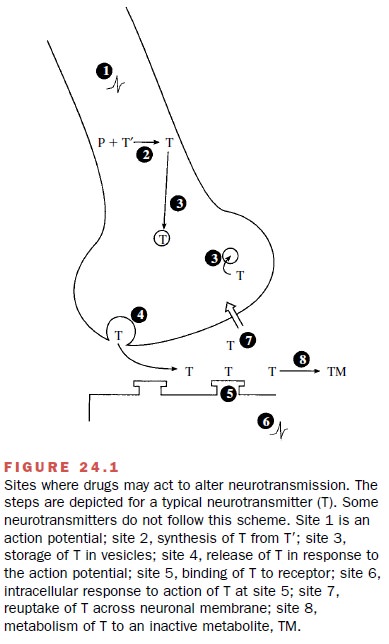Chapter: Modern Pharmacology with Clinical Applications: Introduction to Central Nervous System Pharmacology
Review of Basic Neuroscience
REVIEW OF BASIC
NEUROSCIENCE
The functional unit of the
central nervous system (CNS) is the neuron, and most neuropharmacological
agents have the neuron as their primary site of action. CNS neurons are capable
of transmitting information to and receiving information from other neurons and
periph-eral end organs, such as muscle cells, glandular cells, and specialized
receptors, for example, those involved with proprioception, temperature
sensing, and so on.
The depolarization associated
with an action poten-tial results in the calcium-facilitated release of a
specific chemical substance at the synapse between two neurons . This chemical
substance or neurotrans-mitter is
released, diffuses across the synaptic cleft, and interacts with the membrane of the second neuron to ini-tiate a
local change in the ionic composition and a local altered potential difference
in the second neuron. This potential difference change is known as a postsynaptic potential, and the direction of the potential change may be either depolarizing or hyperpolarizing.
A depolarizing postsynaptic potential is called an excitatory postsynaptic potential
(EPSP). If the magnitude of depolarization pro-duced by EPSPs in the second
neuron is great enough, an action potential produced in the second neuron will
be transmitted in an all-or-none fashion through the neuron and its processes.
If, on the other hand, a hyperpolarizing potential (known as an inhibitory postsynaptic potential, or
IPSP) is produced, it will inhibit the formation of de-polarizing action
potentials.
Most cells normally receive a
large excitatory input with a more or less constant generation of action
po-tentials. The net result of generated IPSPs will be to de-crease the number
of nerve impulses per unit of time. By these mechanisms, neurotransmitters
producing ei-ther an EPSP (excitatory
neurotransmitter) or an IPSP (inhibitory
transmitter) directly influence the number of action potentials generated
by the neurons with which they interact.
Morphologically, many
synapses in the CNS appear to be quite similar to those for the peripheral
auto-nomic nervous system. Electron microscopic studies have verified the
similarities and have shown the pres-ence of several types of storage vesicles
in the areas of synapses. Neurons may synthesize, store, and release one or
more transmitters. Many more synapses exist in the CNS than in the periphery,
and many more neuro-transmitters appear to be involved.
The several ways in which
pharmacological agents can either increase or decrease neurotransmission are
illustrated in Fig. 24.1. The agent can increase the amount of transmitter at
the synapse and thereby pro-duce an exaggerated effect. This can be
accomplished by (1) increasing the rate of transmitter synthesis, (2)
in-creasing the rate of transmitter release, or (3) prolong-ing the time the
transmitter is in the synapse. This last mechanism can be accomplished either
by inhibiting en-zymatic breakdown or by inhibiting the reuptake of a
previously released transmitter.

In contrast, an agent can produce a diminished re-sponse by (1) decreasing synthesis of transmitter, (2) in-creasing transmitter metabolism, (3) promoting an in-creased neuronal uptake, or (4) blocking access of the transmitter to its receptor. The first three processes tend to diminish the amount of transmitter in the synaptic cleft. Some agents (including several useful drugs) pos-sess most of these capabilities at norepinephrine, dopamine, serotonin, histamine, and acetylcholine (ACh) synapses. Several important drugs interfere with other CNS transmitter systems, particularly some of the amino acid transmitters, in some of the above-men-tioned ways to produce their effects.
In the mammalian CNS powerful
inhibitory systems function continually to slow the number of action
po-tentials generated. The effects of stimulating an excita-tory pathway can
appear to be exaggerated if normal in-hibitory influences to that region are
diminished. Correspondingly, an inhibitory pathway will appear ex-aggerated if
part of the excitatory influence to that sys-tem has been removed.
Related Topics